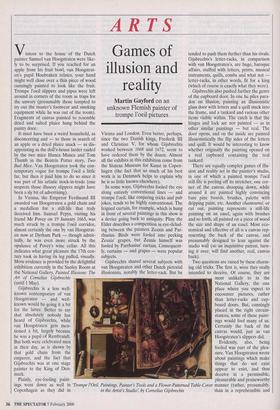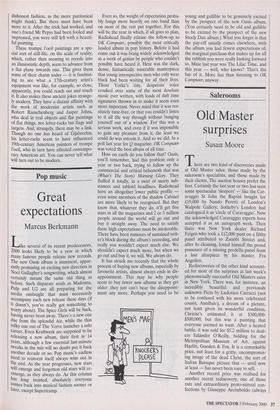ARTS
Games of illusion and reality
Martin Gayford on an unknown Flemish painter of trompe l'oeil pictures Visitors to the house of the Dutch painter Samuel van Hoogstraten were like- ly to be surprised. If you reached for an apple from his fruit bowl, van Hoogstrat- en's pupil Houbraken relates, your hand might well close over a thin piece of wood cunningly painted to look like the fruit. Trompe l'oeil slippers and pipes were left around in corners of the room as traps for the unwary (presumably those tempted to try out the master's footwear and smoking equipment while he was out of the room). Fragments of canvas painted to resemble dried and salted plaice hung behind the pantry door.
It must have been a weird household, as disconcerting and — to those in search of an apple or a dried plaice snack — as dis- appointing as the doll's-house larder raided by the two mice Hunca Munca and Tom Thumb in the Beatrix Potter story, Two Bad Mice. Van Hoogstraten took the con- temporary vogue for trompe l'oeil a little far, but then it paid him to do so since it was part of his artistic stock-in-trade (one suspects those illusory slippers might have been a sly bit of advertising).
In Vienna, the Emperor Ferdinand III awarded van Hoogstraten a gold chain and a medallion for a still-life that truly deceived him. Samuel Pepys, visiting his friend Mr Povey on 19 January 1663, was much struck by a trompe l'oeil corridor, almost certainly the one by van Hoogstrat- en now at Dyrharn Park — though admit- tedly, he was even more struck by the opulence of Povey's wine cellar. All this indicates what great pleasure the 17th cen- tury took in having its leg pulled, visually. More evidence is provided by the delightful exhibition currently in the Smiley Room at the National Gallery, Painted Illusions: The Art of Cornelius Gijsbrechts (until 1 May).
Gijsbrechts is a less well- known contemporary of van Hoogstraten — and well- known would be going it a bit for the latter. Better to say that absolutely nobody has heard of Gijsbrechts, while van Hoogstraten gets men- tioned a bit, largely because he was a pupil of Rembrandt. But both were celebrated men in their day, as is shown by that gold chain from the emperor, and the fact that Gijsbrechts was at one stage painter to the King of Den- mark.
Plainly, eye-fooling paint- Vienna and London. Even better, perhaps, since the two Danish kings, Frederik III and Christian V, for whom Gijsbrechts worked between 1668 and. 1672, seem to have ordered them by the dozen. Almost all the exhibits in this exhibition come from the Statens Museum for Kunst in Copen- hagen (the fact that so much of his best work is in Denmark helps to explain why he is so little known elsewhere).
In some ways, Gijsbrechts fooled the eye along entirely conventional lines — and trompe l'oeil, like conjuring tricks and pub jokes, tends to be highly conventional. The feigned curtain, for example, which is hung in front of several paintings in this show is a device going back to antiquity. Pliny the Elder describes a competition in eye-delud- ing between the painters Zeuxis and Par- rhasius. Birds were fooled into pecking Zeuxis' grapes, but Zeuxis himself was fooled by Parrhasius' curtain. Consequent- ly, curtains — and grapes — were popular subjects.
Gijsbrechts shared several subjects with van Hoogstraten and other Dutch pictorial illusionists, notably the letter-rack. But he ings went down as well in Trompe Weil. Paintings, Painter's Tools and a Flower-Patterned Table-Cover manner (rather, presumably, Copenhagen as they did in in the Artist's Studio', by Cornelius Gijsbrechts than in a reprehensible and tended to push them further than his rivals. Gijsbrechts's letter-racks, in comparison with van Hoogstraten's, are huge, baroque affairs, stuffed with letters, prints, musical instruments, quills, combs and what not — letter-racks, in other words, fit for a king (which of course is exactly what they were).
Gijsbrechts also pushed further the genre of the cupboard door. In one he piles para- dox on illusion, painting an illusionistic glass door with letters and a quill stuck into the frame, and a tankard and various other items visible within. The catch is that the hinges and lock are not painted — as in other similar paintings — but real. The door opens, and on the inside are painted illusionistically the flip sides of the letters and quill. It would be interesting to know whether originally the painting opened on a real cupboard containing the real tankard.
There are equally complex games of illu- sion and reality set in the painter's studio, in one of which a painted trompe l'oeil still-life is peeling off its stretcher, one cor- ner of the canvas drooping down, while around it are painted highly convincing bare pine boards, brushes, palette with dripping paint, etc. Another chantourne, or cut out, painting represents a still-life painting on an easel, again with brushes and so forth, all painted on a piece of wood the size and shape of an easel. Most eco- nomical and effective of all is a canvas rep- resenting the back of the canvas, and presumably designed to lean against the studio wall (so an inquisitive patron, turn- ing it over, will find another, real, canvas back).
Two questions are raised by these charm- ing old tricks. The first is, were they really intended to deceive. Of course, they are most unlikely to in the National Gallery, the one place where you expect to encounter pictures, rather than letter-racks and cup- board doors. But, cunningly placed in the right circum- stances, some of these paint- ings would fool many of us. Certainly the back of the canvas would, just as van Hoogstraten's slippers did.
Evidently, also, being fooled was part of the plea- sure. Van Hoogstraten wrote about paintings which make things that do not exist appear to exist, and thus deceive in a permissible, pleasurable and praiseworthy dishonest fashion, as the more puritanical might think). But there must have been more to it. After the trick had worked, and one's friend Mr Pepys had been fooled and impressed, you were still left with a beauti- ful painting.
These trompe l'oeil paintings are a spe- cial sort of still-life, on the scale of reality, which, rather than seeming to recede into an illusionistic depth, seem to advance from a flat plane towards one. This gives them some of their charm today — it is fascinat- ing to see what a 17th-century artist's equipment was like, for example, so close, apparently, you could reach out and touch it. It also makes these ancient jokes strange- ly modern. They have a distant affinity with the work of modernist artists such as Robert Rauschenberg and Jasper Johns, who deal in real objects and flat paintings of flat things, not letter-racks but flags and targets. And, strangely, there may be a link. Though no one has heard of Gijsbrechts, his letter-racks seem to have influenced 19th-century American painters of trompe l'oeil, who in turn have affected contempo- rary American art. You can never tell what will turn out to be modern.



























































 Previous page
Previous page